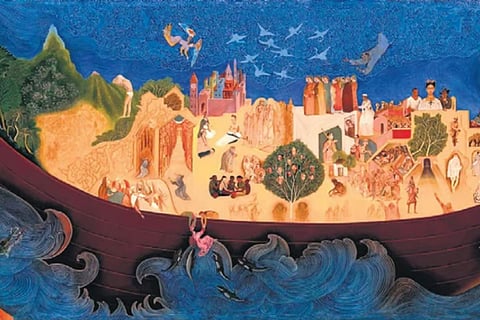
- LIFESTYLE
- FASHION
- FOOD
- ENTERTAINMENT
- EVENTS
- CULTURE
- VIDEOS
- WEB STORIES
- GALLERIES
- GADGETS
- CAR & BIKE
- SOCIETY
- TRAVEL
- NORTH EAST
- INDULGE CONNECT

Have you ever imagined what it may look like to see the world’s greatest painters together, and that too, as fellow-travellers? Vadhera Art Gallery has just organised a Gulam Mohammed Sheikh exhibition, where ‘Kaarawaan’, painted on an 80 x 257-inch canvas, depicts a coming-together voyage of great artists such as Pablo Picasso, Frida Kahlo, Diego Rivera, Jan van Eyck, Rabindranath Tagore, MF Husain, Vincent van Gogh, FN Souza, and many more. The motivation for creating such a piece was to have the past converge with the present. “We live in multiple times, hence revisiting the past is normal in our psyche. So, to call artists of the past into the company of the contemporary in the ark of life was natural. I like to play with the idea of multiple times set in multiple situations to create a new multi-dimensional world,” says the artist.
The work on ‘Kaarawaan’ began sometime in 2022, when the world gradually returned to normalcy as the Covid-19 pandemic ebbed. “My assistants and I started working on this canvas about one-and-a-half years ago after having made a series of drawings before the pandemic. It was a long process of making, unmaking and re-making images on the canvas with trials, erasures, and repainting. It was a voyage of sorts. In the end, the images of pre-modern times found space alongside the contemporary; humans, animals, and vegetation all assembled to form a ‘Kaarawaan’,” he says.
Entering different realms
The main gallery of Bikaner House, which houses Sheikh’s exhibition, begins with two panels, called the ‘Kaavad’, a three-dimensional painting that appears as a box when shut, and promises the viewer entry into different realms when opened.
The box has many doors, containing images; small or big, left or right, recto or verso and are folded in a way that the two halves come together. It is like a door that is waiting to reveal a new world behind it. One such panel is of Gandhi’s where each set of doors reveals him in different stages of his life. The archive at Ahmedabad’s Navjivan Trust is where Sheikh found the inspiration for this Kaavad.
Painting saints is a constant in Sheikh’s work. “Figures like Kabir and Gandhi, who embraced the worldly and spiritual with natural ease and strove to bring communities together, have become symbols, means and fellow travellers in Sheikh’s work,” writes Professor R. Siva Kumar in the exhibition essay.
A world war destructs a world map
Another work, ‘Francis and Kabir’, brings us closer to the saints who have “healed mankind in the face of turbulence”. This painting features an improvised 13th-century circular map of the world, the Ebstorf Mappamundi, and depicts the “violent world” we have been living in. The map was created by Gervase of Ebstorf, roughly between 1234 to 1240, and was found in a convent in Ebstorf, Germany, in 1843. Unfortunately, it was destroyed in 1943 during the Hanover bombing of World War II. What survived were black-and-white photographs of the map, which were later reproduced. “I was fascinated by the fact that a world map was destroyed during the world war,” says the artist.
Inspired by this, Sheikh painted St Francis and Kabir on each side of the canvas, with Gandhi in the circular map between the two saints. Images of violence and peace comprise the map. It features instances of violence -- for example, the Syrian toddler who drowned, in an attempt to reach the Greek island of Kos, and washed up on a beach, or the Aleppo civil war, or migration events in India, and from around the world. “We live in an increasingly violent world, but how do we tackle it without being propagandist? I decided to bring in images of Gandhi, Kabir and St Francis to redeem this turbulent world with a healing touch. The canvas, ‘Francis and Kabir’, quotes them from archival references of paintings,” he says.
The circular map in ‘Francis and Kabir’ has been tweaked so that it can resonate with everyone. “My reworkings on that map bypasses orthodox religiosity, erases borders between regions, even East and West. Kabir appears as the weaver that he was and St Francis appears speaking to birds. Using newer symbols and motifs makes it multi-dimensional and contemporary, conveying the message of peace amid violence. Just as an activist protests when the world faces turbulence to express his dissent, an artist paints it,” he says.